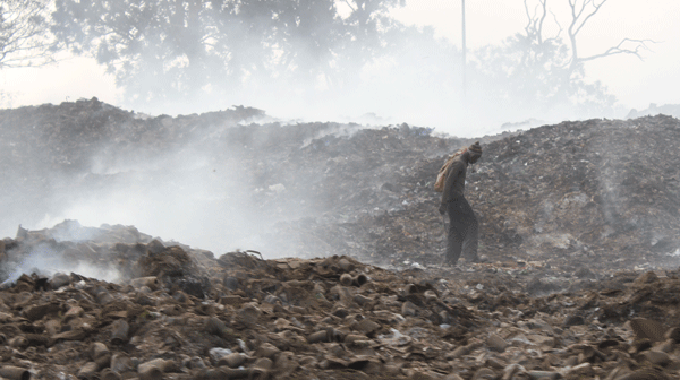EDITORIAL COMMENT : Dumpsite pollution: All talk and no action

The public response to the latest outbreak of fire at Pomona dumpsite demonstrates greater awareness of the dangers toxic fumes pose to residents of the capital if not brought under control immediately.
Companies have rushed in with offers of fuel to enable a bulldozer, to clear a pathway between the burning section of the dumpsite and the unaffected side; water companies, bowsers and fire tenders to douse the section of the dumpsite on fire and also create “a wet fire guard” ring-fencing the burning section; and tipper trucks to move sand onto the cleared pathway, making it safer for trucks to navigate.
Others have come to the rescue with bottled water and take-away meals for the teams of volunteers.
This is a remarkable show of what people, united and with a common purpose, can achieve. Contrast this with the repeated dragging of feet by the local authority in bringing finality to the dumpsite fires.
Since the first decade of the millennium, the fires at Pomona have been a regular occurrence.
By now there should be a plan to anticipate outbreaks of the fires this time of the year, as well as a strategy on how to prevent or manage them.
If prevention is not possible, then at least the aim should be on minimising the air pollution emanating from the dumpsite fires.
Of particular concern is that this year’s fires are taking place against the background of the global coronavirus, one of whose manifestations is respiratory conditions.
Apart from fears of Covid-19, there appears laxity, on the part of the local authority, on acting to prevent recurrence of the dumpsite fires. The toxic emissions have implications for climate change impacts, especially damage to the ozone layer.
Pollution is being released into the air and is inhaled by citizens of Harare. The pollution from the fires affects the health of people with respiratory conditions, the elderly as well as children, increasing the risk of heart conditions, headaches and unexplained rashes.
Plastic and other waste being burnt, produce toxic fumes, among them dioxin and furan. Dioxin, if inhaled, immediately causes coughing, shortness of breath and dizziness. Long-term exposure to it is associated with cancer.
Residents acutely affected are those in Pomona, Vainona, Northwood, Mount Pleasant, Marlborough, Ashbrittle, Avonlea, Emerald Hill and parts of Avondale — areas to the west and south-west of the dumpsite .
Past research paints a worrying picture of the pathway of the pollution from Pomona. The polluted air can traverse the city to the high-density areas to the west and travel frighteningly, as far as Beatrice, Chegutu and Kadoma.
The residual ash from the dumpsite fire can contain toxic materials carried by the wind, which eventually end up seeping into the ground, affecting ground water and the quality of water in general.
There is also concern about heavy metals leaching into the ground water at a time when Zimbabweans are increasingly reliant on borehole water.
When organic waste decomposes, carbon dioxide and methane gas are created. Methane results from absence of air, while carbon dioxide is the product of anything decomposing.
The two are greenhouse gases, which contribute to global warming and climate change.
Initial estimates indicate that the dumpsite fire, which started on Friday will take a week to extinguish, if the current level of support to put out the fire is maintained.
The Pomona fire — although on a much larger scale — is one of several witnessed across the capital city, and daily in other urban areas and across the country, adding to pollution and threatening the quality of the air citizens breathe and the water they drink.
Toxic chemicals from plastic burning are known to result in premature births, stillbirths, and growth retardation and, in some cases, resistance to medication.
There are also harmful effects to new-born babies, breast growth and testicular cancers.
The World Health Organisation (WHO) warns that air pollution causes serious health problems, even where the pollution levels are much lower than WHO limits.
Residents — especially mothers, infants and the elderly living in areas within the vicinity of the dumpsite — are at risk of compromised immunity, resulting from inhaling polluted air.
Suggestions have been made for the relocation of the dumpsite, due to pollution fears and the attendant effects on residents of Harare.
There is little evidence, however, to suggest the local authority is seized with a search for an alternative site. Worryingly, activity at the decommissioned Warren Park dumpsite suggests it is back in use, its location in the middle of residential areas, notwithstanding.
For example, it is estimated that the November 2016 Pomona dumpsite fire exposed more than half of the residents of the city to poisonous smoke.
Each year, therefore, residents of Harare are slowly being poisoned, while the council does little and regrettably, the Environmental Management Agency (EMA) appears incapable of policing and enforcing anti-pollution measures, or promoting effective waste management.
EMA’s enforcement could be in three parts, the first would be to ensure the local authority has interest in exercising oversight in management of the dumpsite so that there are no outbreaks of fires in future.
The second would be to enforce recycling of the waste material being dumped at Pomona, while the third would be establishment of an alternative dump site. Such a site should, at least, avoid its location on the windward side of residential areas.
Previous failed negotiations indicated potential for production of organic fertiliser, basing on the refuse from the dump site. There must be an opportunity for investors to recycle the waste into production of fertiliser.










Comments